I thought I'd post some work in progress photos of the bookcase I promised to my wife two years ago! I've been building it with maple to match a credenza I built at the end of 2021. I'm using this Finewoodworking article as the design. Elegant Bookcase, Top to Bottom - FineWoodworking Ever since I saw it, I knew I wanted to try some variation of it. I won't have any drawers at the top, and the legs will be different to slightly match the credenza. I started with 8/4 and resawed. It almost worked! Some of the boards for the shelving twisted too much, so I had to use some other maple on the shelf. The goal was to book match all of it, but the sides are the only parts that are truly book matched now.


After glue up, I used a Stanley #80 to clean up the glue lines and smooth any irregularities. As you'll see, my hand tool skills are still limited, I'm enjoying learning and seeing positive results.


I rabbeted the sides to accept the face frame on the table saw with a dado set, and then I used my router at my first attempt at sliding tapered dovetails. I used an old piece of plywood I squared up as the guide/jig. I cut it down each time I moved to the next cut for the shelf. You can see the small piece of edge banding with tape on the end that I used to create the taper. I used a caul to ensure the side was flat as well. Due to the length of time in between all the steps, some of the wood moved again - but I had to make due. I'm a big fan of the dust collection on this dewalt router.

I then went to the router table to cut the dovetail angle on the ends of the shelving. I saw this set up in another finewoodworking video. I took a piece of 1/4" mdf and covered the top of the table to ensure a smooth and flat ride. I then screwed in a piece of plywood to the fence that was already there. I did have to shim it slightly to get it perfectly square. Then I ran it through using a microjig pushblock with a heel on it. I used a piece of edge banding taped to the end for the tapered side. Surprisingly it worked!! I was able to dial it in slowly and then used a sanding block cut at the same angle as the dovetail to clean up any tightness when dryfitting. And of course I used the best looking joint for the picture! I had some blowout on the other shelving, but it will be covered by the face frame.


I then resawed and milled some additional boards to 3/8" for the back. I'm using the spline method for the joinery and leaving about a 1/16" between each board. The back sits into a dado that was cut into the sides and bottom and back rail using a 1/4" box cutting blade on the table saw. Here is a dryfit before cutting the front top rail and face frame to length. I notched the bottom using a handsaw with a guide. It seemed to work, but I overcut from one side...fortunately it wasn't the show side.



I'd like to place one screw in the center of each back board into the shelf to tighten up any gaps between the back and shelving. I think this would still allow for wood movement without causing stress on the joinery. Does anyone see any glaring issues with that?
After glue up, I used a Stanley #80 to clean up the glue lines and smooth any irregularities. As you'll see, my hand tool skills are still limited, I'm enjoying learning and seeing positive results.
I rabbeted the sides to accept the face frame on the table saw with a dado set, and then I used my router at my first attempt at sliding tapered dovetails. I used an old piece of plywood I squared up as the guide/jig. I cut it down each time I moved to the next cut for the shelf. You can see the small piece of edge banding with tape on the end that I used to create the taper. I used a caul to ensure the side was flat as well. Due to the length of time in between all the steps, some of the wood moved again - but I had to make due. I'm a big fan of the dust collection on this dewalt router.
I then went to the router table to cut the dovetail angle on the ends of the shelving. I saw this set up in another finewoodworking video. I took a piece of 1/4" mdf and covered the top of the table to ensure a smooth and flat ride. I then screwed in a piece of plywood to the fence that was already there. I did have to shim it slightly to get it perfectly square. Then I ran it through using a microjig pushblock with a heel on it. I used a piece of edge banding taped to the end for the tapered side. Surprisingly it worked!! I was able to dial it in slowly and then used a sanding block cut at the same angle as the dovetail to clean up any tightness when dryfitting. And of course I used the best looking joint for the picture! I had some blowout on the other shelving, but it will be covered by the face frame.
I then resawed and milled some additional boards to 3/8" for the back. I'm using the spline method for the joinery and leaving about a 1/16" between each board. The back sits into a dado that was cut into the sides and bottom and back rail using a 1/4" box cutting blade on the table saw. Here is a dryfit before cutting the front top rail and face frame to length. I notched the bottom using a handsaw with a guide. It seemed to work, but I overcut from one side...fortunately it wasn't the show side.
I'd like to place one screw in the center of each back board into the shelf to tighten up any gaps between the back and shelving. I think this would still allow for wood movement without causing stress on the joinery. Does anyone see any glaring issues with that?

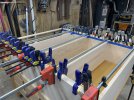
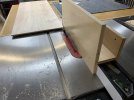
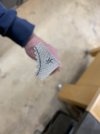
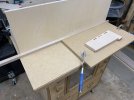
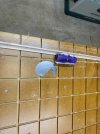
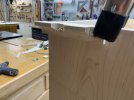
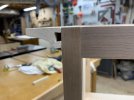
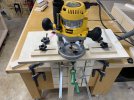
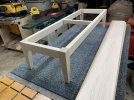
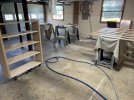
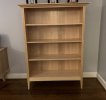
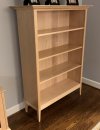
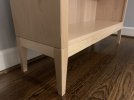
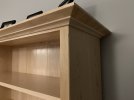
 can you give some more detail on how that would be done? That sounds much better than brass screws that can break off even using wax and screwdriver to drive them in. Not that that happened to me 3x on this project.
can you give some more detail on how that would be done? That sounds much better than brass screws that can break off even using wax and screwdriver to drive them in. Not that that happened to me 3x on this project.